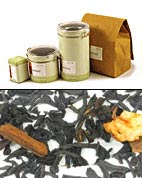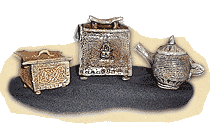Brandelic Artistry
A Land of Ever Changing Creativity and Wonder
The Brandelic Tea Garden
Welcome to our tea room, a mighty fine place to learn a little bit about your favorite teas, and heck if you crave a delicious tea why not pick up a bag or two - we'll feature a new tea to try from time to time. There is nothing like sitting down to a warm cup of your favorite Jasmine Oolong tea and enjoying a little hand made art, well maybe finding a wad of twenties on the sidewalk, but work with me here I'm trying to set the mood.
Below you'll find an overview of the major types of tea: black, white, green, oolong, and the fun to pronounce rooibos (roy-bus or roy-boss I still don't know which is correct). As time permits we'll be putting together more in depth information on each type as well as the opportunity to purchase some of these fine teas from Adagio Teas - a pretty spiffy little online tea emporium perfect for trying new teas of all kinds. So keep your eyes open and your taste buds perked it's going to be groooovy!
 |
Try Chocolate Chai Supreme tea, a signature tea blend perfect for a tea-licious treat!This holiday tea blend consists of delicious Masala Chai, Chocolate chip, and hazelnut black teas. It is the perfect tea blend to relax with after a stressful evening - great with a touch of milk and sugar! |
Black tea is known to lower cholesterol, prevent tooth decay, and is mighty fine for the heart. It is also a mild stimulant so makes a great morning tea. A good cup of English breakfast tea with a touch of milk and sugar is one of our favorite memories of an Autumn trip to Maine. |
Green tea is great for digestion and the regulation of blood sugar levels. It also may help prevent cancer and lower cholesterol. For a triple treat it also helps prevent cavities and aging - so stock up on the Green and sip the fountain of youth, or just drink it because it tastes good. |
White tea is the rare magic elixir of life. It is very high in those funky fresh antioxidants, helps detoxify the body, and studies show that white tea is great for the skin and may actually reduce fine lines and wrinkles. It also may slow the growth of some types of cancer. |
Rooibos or Red tea, has even more antioxidants than green tea so packs in even more good for you-ness. It also improves digestion is good for the skin, helps those pesky allergies, and is high in vitamins and minerals. Plus it is a blast just figuring out how to say it. Yikes! |
Also known as Wu-long, or "Black Dragon" Tea, Oolong is a relaxing tea that is good for the skin, enhances the metabolism and thus is good for digestion. Oolong tea is commonly brewed to be strong, with the bitterness leaving a sweet and pleasant aftertaste. |
 |
How to Brew the Perfect Cup of Tea
-
Fill your tea kettle with cold water, cold water retains more oxygen resulting in a fuller flavor. If your tap water is hard, use filtered or bottled water.
-
While the water is heating, pre-heat your teapot by filling it with hot tap water (you could also microwave a cup of water), let it warm, then drain it completely.
-
Measure into the teapot 1 tsp. of loose tea for every cup you plan to pour. If you take milk with your tea, add an extra spoonful to retain the correct concentration. For white tea add 1 1/2 - 2tsp. per cup as it is a more delicate tea leaf. If you are using a mesh tea ball, don't fill it more than halfway, to allow the tea leaves to completely expand.
-
Bring the water to a full boil for black tea and rooibos tea, remove the tea kettle from the heat as soon as the water begins to boil as over boiling will flatten the tea's flavor. For more delicate green tea, white tea, and oolong tea remove the teakettle from the heat before the water begins to boil. Japanese Green tea and White tea at about 160-170 degrees F. Standard green tea at 170-180 degrees, and oolong at 180-200 degrees. Experiment with these ranges to find your perfect cup of tea.
If you don't have a thermometer handy, you can tell the water temperature by watching the bubbles. Small bubbles will float to the surface of the water at 160-170F, and you'll see strings of bubbles from the bottom of the kettle at 180-190F. After that, you'll have a full rolling boil. For easy viewing of those bubbles try using a glass teakettle.
-
Before steeping, pour a small amount of the hot water over the tea leaves to allow them to bloom, or open up, and release some of their bitter tannins. Drain that water immediately - say bye bye to Mr. Tannin.
-
Fill the pot with the boiling water. Keep the spout of the kettle close to the teapot, so the water does not cool as you pour it in. Cover the teapot and leave the tea to brew. In general, black teas are best brewed for 4 to 5 minutes; green teas should brew for no more than 3 minutes. White teas anywhere from 4 to 15 minutes, oolong tea 1 to 9 minutes, and Rooibos tea 6 to 8 minutes. Alter brew times to suit your taste. If using tea bags dramatically reduce steeping times as the tea is cut finer resulting in quicker infusion.
-
When the tea is done steeping, pour and serve all the tea if possible. Otherwise remove the tea leaves from the pot as over brewed tea tends to taste bitter - good 'ol Mr. Tannin. To keep the tea warm through several cups, transfer the tea to an insulated pot or cover your teapot with a tea cozy. Don't apply additional heat to keep the tea warm, as this will quickly degrade its flavor.
-
A good-quality loose leaf tea can be infused three to five times, in fact some teas get better after the first brew. Just add more hot water. Let it steep for less time with each brew. (that may seem contradictory, and there is some debate among tea experts regarding second cup steep times, some say steep less some say more, or even add a bit of fresh tea leaves to the second pot. Experiment, have fun and enjoy your tea!)
Select a Gallery:
- Brandi's Galleries:
Figurine/Pottery Gallery
Photography Gallery
Drawing Gallery
Jewelry Gallery - Chris's Galleries:
Photography Gallery
Drawing Gallery
Jewelry Gallery

